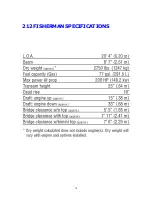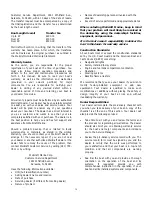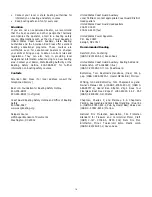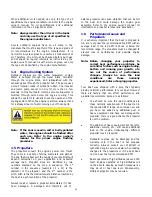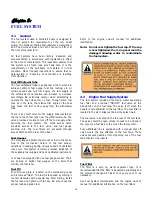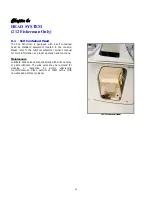
When additional oil is needed, use only the type of oil
specified by the engine manufacturer. Refer to the engine
owner’s manual for oil specifications and additional
information on the oil injection system.
Note: Always monitor the oil level in the tanks
and only use the type of oil specified by
the engine manufacturer.
4-cycle outboard engines have an oil sump in the
crankcase that must be kept full of the type and grade of
oil recommended by the engine manufacturer. It is
normal for 4-cycle engines to consume a small amount of
oil. Therefore, the oil must be checked before each use
and changed at regular intervals as instructed by the
engine owner’s manual. As with 2-cycle engines, use only
the type of oil specified by the engine manufacturer.
1.4
Engine Cooling System
Outboard engines are raw water (seawater) cooled.
Water is pumped through the water inlets, circulated
through the engine block, and relinquished with the
exhaust gases through the propeller hub. The pump uses
a small impeller made of synthetic rubber. The impeller
and water pump cannot run dry for more than e few
seconds. In most outboard motors, some cooling water is
diverted through ports below the engine cowling. This
allows the operator to visually check the operation of the
cooling system. When the engine is started, always check
for a steady stream of water coming out of those ports.
Note: If the boat is used in salt or badly polluted
water, the engines should be flushed after
each use. Refer to the engine owner’s
manual for the proper engine flushing
procedure.
1.5
Propellers
The propellers convert the engine’s power into thrust.
They come in a variety of styles, diameters and pitches.
The one that will best suit the needs of your Wellcraft will
depend somewhat on your application and expected
average load. Propeller sizes are identified by two
numbers stamped on the prop in sequence. The 1
st
number in the sequence (example 14 x 21) is the
diameter of the propeller, and the 2
nd
number is the
pitch. Pitch is the theoretical forward distance traveled by
the boat in each revolution of the propeller.
Always repair or replace a propeller immediately if it has
been damaged. A damaged and therefore out of
balance propeller can cause vibration that can be felt
in the boat and could damage the engine gear
assembly. Refer to the engine owner’s manual for
information on propeller removal and installation.
1.6
Performance Issues and
Propellers
It is extremely important that the boat is propped to
run at or very near the recommended top RPM with an
average load. If the top RPM is above or below the
recommend range, the propellers must be changed to
prevent loss of performance and possible engine
damage.
Note: Before changing your propeller to
correct boat performance problems, be
sure other factors such as engine tuning,
bottom and running gear growth, etc.
are not the source of performance
changes. Always be sure the load
conditions are those normally
experienced, before changing propeller.
Your boat was shipped with a prop that typically
provide optimum performance for your boat. However
there are factors that can affect performance and
propeller requirements. Some are as follows:
•
You should be sure the load conditions are
those normally experienced. If the boat ran in
the required RPM range when it was new and
you have not added any additional gear or
heavy equipment and have not damaged the
propeller, there is a good chance the propeller
is not the problem.
•
The addition of heavy equipment like life rafts,
additional coolers, etc., will cause additional
load on the engine. Consequently, different
propeller may be required.
•
Outboard engines can be damaged and the
warranty void if the boat is not propped
correctly. Always consult your Wellcraft or
authorized engine service dealer when making
changes to the propellers or if the boat does
not run near the top recommended RPM.
•
Boats operated at high altitudes (above 2000
feet). Engines operated at high altitudes will
not be able to develop as much horsepower as
they do at or near sea level. Consequently,
different propeller may be required.
23
Summary of Contents for 180 Sportsman
Page 2: ...2...
Page 4: ...4...
Page 7: ...180 FISHERMAN SPECIFICATIONS 7...
Page 8: ...180 SPORTSMAN SPECIFICATIONS 8...
Page 9: ...202 FISHERMAN SPECIFICATIONS 9...
Page 10: ...212 FISHERMAN SPECIFICATIONS 10...
Page 18: ...18...
Page 39: ...SAFETY LABELS 2601 1124 39...
Page 40: ...180 FISHERMAN 180 SPORTSMAN CAPACITY LABELS 40...
Page 41: ...202 212 FISHERMAN CAPACITY LABELS 41...
Page 61: ...Appendix A SCHEMATICS 180 FISHERMAN INSTRUMENT PANEL 61...
Page 62: ...Appendix A SCHEMATICS 180 SPORTSMAN INSTRUMENT PANEL 62...
Page 63: ...Appendix A SCHEMATICS 202 212 FISHERMAN INSTRUMENT PANEL 63...
Page 68: ...Appendix A SCHEMATICS 180 FISHERMAN 180 SPORTSMAN TRAILER DRAWING 68...
Page 69: ...Appendix A SCHEMATICS 202 212 FISHERMAN TRAILER DRAWING 69...
Page 70: ...Appendix A SCHEMATICS 180 FISHERMAN OVERHEAD LAYOUT 70...
Page 71: ...Appendix A SCHEMATICS 180 SPORTSMAN OVERHEAD LAYOUT 71...
Page 72: ...Appendix A SCHEMATICS 202 FISHERMAN OVERHEAD LAYOUT 72...
Page 73: ...Appendix A SCHEMATICS 212 FISHERMAN OVERHEAD LAYOUT 73...
Page 77: ...MAINTENANCE LOG 77...
Page 78: ...MAINTENANCE LOG 78...
Page 80: ...Appendix D BOAT ACCIDENT REPORT 80...
Page 81: ...81...
Page 87: ...Appendix F TROUBLESHOOTING GUIDE 87...
Page 88: ...TROUBLESHOOTING GUIDE 88...
Page 89: ...TROUBLESHOOTING GUIDE 89...
Page 90: ...TROUBLESHOOTING GUIDE 90...
Page 91: ...TROUBLESHOOTING GUIDE 91...


